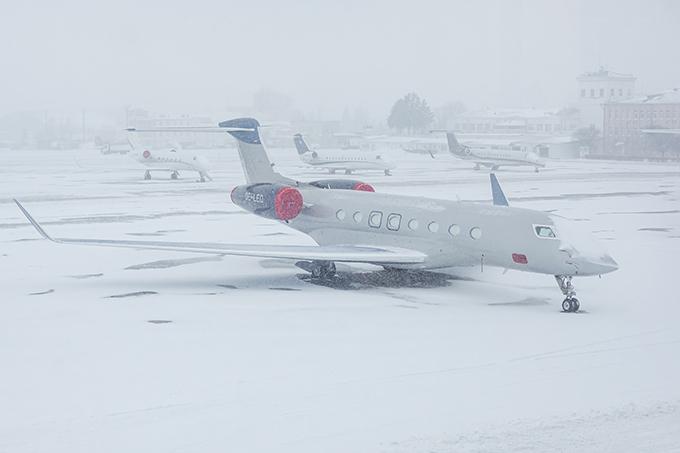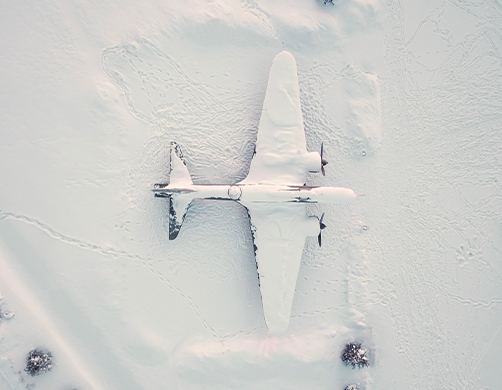
How many types of icing are there? In what conditions do icing occur? It is highly crucial for pilots to know the answers to these questions before flying as it could save a life. Icing is the formation of ice on the surface or within the engine of an aircraft that results in the alteration of speed and hence, requiring greater power to maintain the speed.

Source Picture : Freepik/EyeEm
Icing comes in many forms and sizes. Some with protrusions and some others are smooth. Often times, pilots may also come across a combination of such ice. Clear ice, as it says on its name, is clear and smooth but may form protrusions. These protrusions occur when the large water droplets strike a surface but do not freeze instantly hence, altering the shape of the ice and the shape of the aircraft surface. Rime ice, on the other hand, is rough and opaque formed by supercooled drops of water rapidly freezing on impact. However, rime ice follows the shape of the surface. As mentioned previously, there is a type of ice that is a combination of both clear and rime ice called Mixed Ice.
Unprotected aircraft surfaces that are stationary may also be affected by icing due to the formation of Frost Ice resulted by the freezing of water on such surfaces. Frost Ice causes an aerodynamic stall, increasing drag and making takeoff highly dangerous or even impossible to undergo. Supercooled Liquid Droplet (SLD) ice occurs in SLD conditions. SLD is similar to clear ice where both droplets are large in size. SLD ice extends to unprotected parts of the aircraft, forming a larger ice coverage and altering the shape of the surface greatly.
SLD ice was a great factor in the crash of the American Eagle Flight 4184. This tragedy occurred on October 31st, 1994, taking a total of 68 lives. The aircraft encountered freezing rain, a dangerous SLD icing condition, causing an intense ice buildup on the surface of the aircraft. This resulted in a deadly descent with the aircraft exponentially gaining speed, triggering the overspeed warning. The pilots were able to gain control of the plane during this descent, however, as they entered the following descent, the pilots no longer had control of the plane and eventually lost contact with the controller as the aircraft crashed into a soybean field. The flight data recorder showed the plane to have reached an airspeed of 431 mph during the crash, indicating that the aircraft crashed with extreme velocity.
So, at what conditions do icing occur? During flight, airplanes often fly through clouds made up of small water droplets that are liquid below freezing point. Cumulus and Stratus clouds are two clouds recommended to be avoided when flying as both are icing clouds. During winter, the temperature around these areas could reach -40°C. At such temperatures, pure water can stay in the atmosphere in the liquid state and not freeze. When planes fly through clouds, water freezes due to the impact of the water on the aircraft as now, there is a surface to freeze on. Along with this, the ice forming starts to build up on the edges of the aircraft’s wings, nose and tail surfaces, sometimes even in the engines. Even a small amount of icing would cause difficulty for the aircraft to climb. It is best to avoid all icing conditions as ice builds up incredibly fast!

How many types of icing are there? In what conditions do icing occur? It is highly crucial for pilots to know the answers to these questions before flying as it could save a life. Icing is the formation of ice on the surface or within the engine of an aircraft that results in the alteration of speed and hence, requiring greater power to maintain the speed.
How many types of icing are there? In what conditions do icing occur? It is highly crucial for pilots to know the answers to these questions before flying as it could save a life. Icing is the formation of ice on the surface or within the engine of an aircraft that results in the alteration of speed and hence, requiring greater power to maintain the speed.

Source Picture : Freepik/EyeEm
Icing comes in many forms and sizes. Some with protrusions and some others are smooth. Often times, pilots may also come across a combination of such ice. Clear ice, as it says on its name, is clear and smooth but may form protrusions. These protrusions occur when the large water droplets strike a surface but do not freeze instantly hence, altering the shape of the ice and the shape of the aircraft surface. Rime ice, on the other hand, is rough and opaque formed by supercooled drops of water rapidly freezing on impact. However, rime ice follows the shape of the surface. As mentioned previously, there is a type of ice that is a combination of both clear and rime ice called Mixed Ice.
Unprotected aircraft surfaces that are stationary may also be affected by icing due to the formation of Frost Ice resulted by the freezing of water on such surfaces. Frost Ice causes an aerodynamic stall, increasing drag and making takeoff highly dangerous or even impossible to undergo. Supercooled Liquid Droplet (SLD) ice occurs in SLD conditions. SLD is similar to clear ice where both droplets are large in size. SLD ice extends to unprotected parts of the aircraft, forming a larger ice coverage and altering the shape of the surface greatly.
SLD ice was a great factor in the crash of the American Eagle Flight 4184. This tragedy occurred on October 31st, 1994, taking a total of 68 lives. The aircraft encountered freezing rain, a dangerous SLD icing condition, causing an intense ice buildup on the surface of the aircraft. This resulted in a deadly descent with the aircraft exponentially gaining speed, triggering the overspeed warning. The pilots were able to gain control of the plane during this descent, however, as they entered the following descent, the pilots no longer had control of the plane and eventually lost contact with the controller as the aircraft crashed into a soybean field. The flight data recorder showed the plane to have reached an airspeed of 431 mph during the crash, indicating that the aircraft crashed with extreme velocity.
So, at what conditions do icing occur? During flight, airplanes often fly through clouds made up of small water droplets that are liquid below freezing point. Cumulus and Stratus clouds are two clouds recommended to be avoided when flying as both are icing clouds. During winter, the temperature around these areas could reach -40°C. At such temperatures, pure water can stay in the atmosphere in the liquid state and not freeze. When planes fly through clouds, water freezes due to the impact of the water on the aircraft as now, there is a surface to freeze on. Along with this, the ice forming starts to build up on the edges of the aircraft’s wings, nose and tail surfaces, sometimes even in the engines. Even a small amount of icing would cause difficulty for the aircraft to climb. It is best to avoid all icing conditions as ice builds up incredibly fast!
Dr.Gema Goeyardi as a Gold Seal flight instructor will help you to achieve your dream as a pilot in a fast track accelerated program. His secret recipe of accelerated flight training syllabus has proven to graduate pilots from Private Pilot to ATP world wide in just very short days. As an ATP and Boeing 737 captain he always set a high standard of training and encouraged all students to have a professional pilot qualification standard. Lets talk with Dr.Gema for your training program plan, schedule your check ride, and customize your flexible training journey.
Dr.Gema Goeyardi as a Gold Seal flight instructor will help you to achieve your dream as a pilot in a fast track accelerated program. His secret recipe of accelerated flight training syllabus has proven to graduate pilots from Private Pilot to ATP world wide in just very short days. As an ATP and Boeing 737 captain he always set a high standard of training and encouraged all students to have a professional pilot qualification standard. Lets talk with Dr.Gema for your training program plan, schedule your check ride, and customize your flexible training journey.